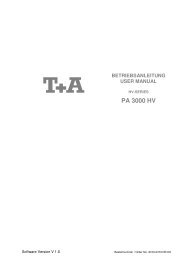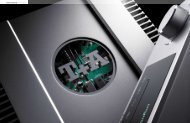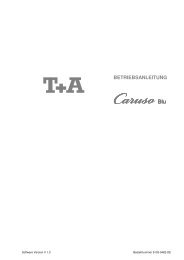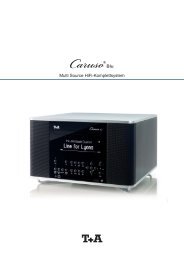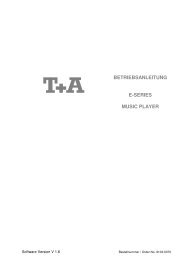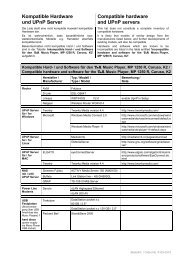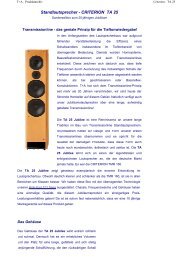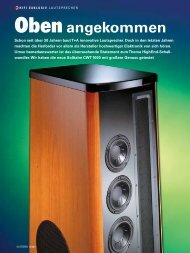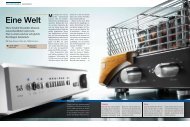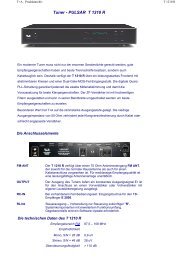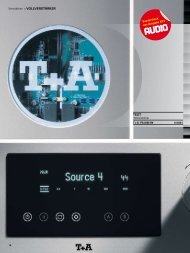CD - SACD - Player - PULSAR SACD 1245 R - T+A Elektroakustik
CD - SACD - Player - PULSAR SACD 1245 R - T+A Elektroakustik
CD - SACD - Player - PULSAR SACD 1245 R - T+A Elektroakustik
You also want an ePaper? Increase the reach of your titles
YUMPU automatically turns print PDFs into web optimized ePapers that Google loves.
<strong>CD</strong> - SA<strong>CD</strong> - <strong>Player</strong> - <strong>PULSAR</strong> SA<strong>CD</strong> <strong>1245</strong> R<br />
The SA<strong>CD</strong> <strong>1245</strong> R is a thoroughbred two-channel player which we developed to provide<br />
the highest standard of stereo reproduction from <strong>CD</strong> and SA<strong>CD</strong>. <strong>T+A</strong>’s overall design<br />
philosophy for audio playback is unique: for each music format there is an independent,<br />
dedicated signal processing section incorporating pulse resynchronisation, designed to<br />
minimise jitter. This is known as the Reverse Clock Process, and was developed by <strong>T+A</strong><br />
ten years ago: the system provides perfect synchronisation of the converter and mechanism<br />
clock signals; there are even separate oscillators for <strong>CD</strong> and SA<strong>CD</strong>.<br />
Connection elements<br />
Mechanism and decoder<br />
This latest generation of highly refined mechanisms is crystal-controlled. The design is<br />
optimised for <strong>CD</strong> and SA<strong>CD</strong> formats with precision dual-laser systems, and tracks discs<br />
with enormous security. Mechanical encapsulation, vibration de-coupling measures and<br />
shielding keep all external influences away from the disc mechanism. The decoder is<br />
equipped with the latest generation of super-performance processors designed for the<br />
various formats; error correction was already good, but we have been able to improve it<br />
further. A crucial factor in the superb overall result is the ingenious, carefully considered<br />
overall design and layout of the individual sub-assemblies. Signal paths are kept to the<br />
absolute minimum length, thereby minimising their susceptibility to interference influences<br />
and conductor losses.<br />
The mains power sections and voltage supplies for the digital and analogue sections are<br />
kept strictly separated, to avoid any trace of interference coupling. Both sections are<br />
extremely stable under load; the analogue mains section is even equipped with a torroidal<br />
transformer. Every stage features multiple<br />
Quadrupel D / A - converter<br />
The new converter is unique even by <strong>T+A</strong><br />
standards. No fewer than eight highly selected<br />
Burr Brown D/A converters are employed; these<br />
are acknowledged as the world’s best. The<br />
quadruple converter enhances the work of the<br />
differential converter. The design of the differential<br />
converter (2 D/A converters operating in<br />
<strong>CD</strong> / SA<strong>CD</strong> - <strong>Player</strong> SA<strong>CD</strong> <strong>1245</strong> R
<strong>T+A</strong> - Produktarchiv<br />
symmetrical push-pull mode) completely cancels<br />
out equal pulse errors, halves uncorrelated<br />
converter errors, and reduces uncorrelated<br />
background noise by 3 dB. The quadruple<br />
converter features twice the number of converters,<br />
i.e. there are now four converters per channel.<br />
This reduces uncorrelated converter errors to one<br />
quarter, and background noise by 6 dB. The effort<br />
invested in this converter layout is immense, but<br />
the results are worthwhile!<br />
Of course, we use a freely programmable signal processor, so the player still features the<br />
switchable oversampling algorithms for <strong>CD</strong> playback for which <strong>T+A</strong> is renowned, i.e. the<br />
listener can select the best possible reproduction to suit his personal taste, according to<br />
the quality and mix of the disc material. For SA<strong>CD</strong> playback our engineers have also<br />
developed oversampling and noise-shaper circuits which can be switched to four different<br />
modes, generating curves of different gradient and secondary wave suppression. These<br />
circuits make it possible to carry out highly effective fine-tuning to match the sound<br />
characteristics of the chain connected to the player. After the conversion section comes<br />
an extremely sophisticated audiophile analogue output section of discrete construction.<br />
To prevent any danger of the digital section influencing the analogue section, these two<br />
sub-assemblies are separated and de-coupled completely using a unique <strong>T+A</strong> circuit<br />
design. The control signals are transferred via opto-couplers, while the latest jitter-free<br />
magnetic iCouplers from Analog Devices are employed to cope with the high-speed data<br />
signals. The overall result is that the machine achieves genuine analogue High-End<br />
sound quality both with <strong>CD</strong> and also with SA<strong>CD</strong>.<br />
Bandwith switching<br />
The DSD process used for SA<strong>CD</strong> inevitably generates increased background noise in the<br />
region above about 40 kHz. Not all amplifiers can cope with this layer of high-frequency<br />
noise. In the simplest case the amplifier simply becomes very warm, but in many cases the<br />
amplifier also generates intermodulation effects or other distortion products, and these can<br />
have an adverse and extremely disturbing effect in the audible frequency range. One<br />
solution for us would have been to limit the frequency response of the player to the lowest<br />
common denominator, in order to cope with amplifiers of moderate quality, and this would<br />
have been the safe route. However, we were not content with this, so we decided to equip<br />
the SA<strong>CD</strong> <strong>1245</strong> R with a pure analogue output filter which can be switched between 60 kHz<br />
and 120 kHz bandwidth. By this means it is possible to set up the player to match any<br />
amplifier very accurately, and where a good, wide-bandwidth amplifier is used, there is no<br />
need to forfeit anything in terms of frequency response and phase linearity.<br />
Specifications:<br />
Formats<br />
Audio <strong>CD</strong>, <strong>CD</strong>-R / RW, SA<strong>CD</strong>-Stereo<br />
<strong>CD</strong> / SA<strong>CD</strong> - <strong>Player</strong> SA<strong>CD</strong> <strong>1245</strong> R
<strong>T+A</strong> - Produktarchiv<br />
Audio<br />
Audio outputs (analogue) Stereo (quadruple circuit with 8 converters)<br />
Audio outputs (digital) 1 x coaxial, 1 optical<br />
IEC 60958 (<strong>CD</strong>DA / LPCM)<br />
IEC 61937 (MPEG1/2, Dolby Digital, dts) (1,2)<br />
Output level / Impedance 2,5 Veff / 22 Ohm<br />
D/A - Converter f. <strong>CD</strong>DA Double-mono-quadrupel 4 x 24 Bit 384 kHz Sigma/Delta<br />
D/A - Converter f. SA<strong>CD</strong> Double-mono-quadrupel DSD-differential converter<br />
Frequency response <strong>CD</strong> 2 Hz - 20 kHz<br />
Total harmonic distortion < 0.001 %<br />
SA<strong>CD</strong> normal 2 Hz - 60 kHz<br />
SA<strong>CD</strong> wide 2 Hz - 120 kHz<br />
Effective system dynamic <strong>CD</strong> 100 dB<br />
Allgemein<br />
SA<strong>CD</strong> 110 dB<br />
Signal / Noise 115 dB (A-weighted)<br />
Channel separation 110 dB<br />
Dimensions (H x W x D) 7,5 x 44 x 39 cm<br />
Remote control über R-System<br />
Finisches Black (RAL 9005)<br />
Alu silver<br />
We reserve the right to alter technical specifications.<br />
<strong>CD</strong> / SA<strong>CD</strong> - <strong>Player</strong> SA<strong>CD</strong> <strong>1245</strong> R



